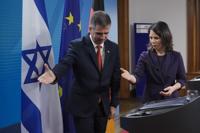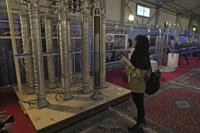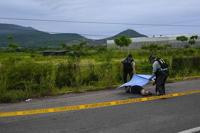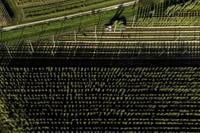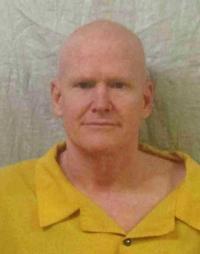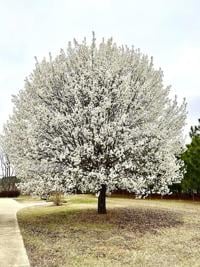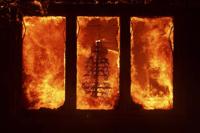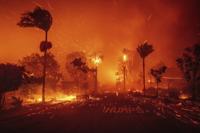VIENNA (AP) — Inspectors from the United Nations nuclear watchdog found uranium particles enriched up to 83.7% in Iran's underground Fordo nuclear site, a report seen Tuesday by The Associated Press said.
The confidential quarterly report by the Vienna-based International Atomic Energy Agency distributed to member states likely will raise tensions further between Iran and the West over its nuclear program. That's even as Tehran already faces internal unrest after months of protests and Western anger over sending bomb-carrying drones to Russia for its war on Ukraine.
The IAEA report only speaks about “particles,” suggesting that Iran isn't building a stockpile of uranium enriched above 60% — the level it has been enriching at for some time.
The IAEA report described inspectors discovering on Jan. 21 that two cascades of IR-6 centrifuges at Iran's Fordo facility had been configured in a way “substantially different” to what had been previously declared. The IAEA took samples the following day, which showed particles up to 83.7% purity, the report said.
“Iran informed the agency that ‘unintended fluctuations’ in enrichment levels may have occurred during the transition period," the IAEA report said. “Discussions between the agency and Iran to clarify the matter are ongoing.”
The IAEA report also said that it would “further increase the frequency and intensity of agency verification activities” at Fordo after the discovery.
Iran’s mission to the United Nations told the AP that Massimo Aparo, a top IAEA official, visited the Islamic Republic last week “and checked the alleged enrichment rate.”
“Based on Iran’s assessment, the alleged enrichment percentage between Iran and the IAEA is resolved,” the mission contended. “Due to the IAEA report being prepared before his trip, his trip’s results aren’t in it and hopefully the IAEA director-general will mention it in his oral report to the board of governors” in March.
A spokesman for Iran’s civilian nuclear program, Behrouz Kamalvandi, also sought last week to portray any detection of uranium particles enriched to that level as a momentary side effect of trying to reach a finished product of 60% purity. However, experts say such a great variance in the purity even at the atomic level would appear suspicious to inspectors.
Iran’s 2015 nuclear deal limited Tehran’s uranium stockpile to 300 kilograms (661 pounds) and enrichment to 3.67% — enough to fuel a nuclear power plant. The U.S.' unilateral withdraw from the accord in 2018 set in motion a series of attacks and escalations by Tehran over its program.
Iran has been producing uranium enriched to 60% purity — a level for which nonproliferation experts already say Tehran has no civilian use. The IAEA report put Iran's uranium stockpile as of Feb. 12 at some 3,760 kilogram (8,289 pounds) — an increase of 87.1 kilograms (192 pounds) since its last quarterly report in November. Of that, 87.5 kilograms (192 pounds) is enriched up to 60% purity.
Uranium at nearly 84% is almost at weapons-grade levels of 90% — meaning any stockpile of that material could be quickly used to produce an atomic bomb if Iran chooses.
While , months more would likely be needed to build a weapon and potentially miniaturize it to put it on a missile. The U.S. intelligence community, as recently as this past weekend, has maintained its assessment that Iran isn't pursuing an atomic bomb.
"To the best of our knowledge, we don’t believe that the supreme leader in Iran has yet made a decision to resume the weaponization program that we judge they suspended or stopped at the end of 2003,” CIA Director Williams Burns told CBS' “Face the Nation” program. “But the other two legs of the stool, meaning enrichment programs, they’ve obviously advanced very far.”
But Fordo, which sits under a mountain near the holy Shiite city of Qom, some 90 kilometers (55 miles) southwest of Tehran, remains a special concern for the international community. It is about the size of a football field, large enough to house 3,000 centrifuges, but small and hardened enough to lead U.S. officials to suspect it had a military purpose when they exposed the site publicly in 2009.
Meanwhile, a top Defense Department official told the U.S. House of Representative's Armed Services Committee on Tuesday that Iran could make enough fissile material for one nuclear weapons in under two weeks if Tehran choose to pursue it.
“Iran’s nuclear progress since we left the (deal) has been remarkable,” Colin Kahl said. “Back in 2018, when the previous administration decided to leave the (deal), it would have taken Iran about 12 months to produce one bomb’s worth of fissile material. Now it would take about 12 days.”
Any explanation from Iran, however, likely won't be enough to satisfy Israel, Iran's regional archrival. Already, Israel’s recently reinstalled Prime Minister . And Israel and Iran have been engaged in a high-stakes shadow war across the wider Middle East since the nuclear deal's collapse.
Meanwhile Tuesday, Germany's foreign minister said both her country and Israel are worried about the allegations facing Iran over the nearly 84% enriched uranium.
“We are united by concern about the nuclear escalation on Iran’s part and about the recent reports about the very high uranium enrichment,” Annalena Baerbock said. “There is no plausible civilian justification for such a high enrichment level.”
Speaking in Berlin, Israel's visiting foreign minister, Eli Cohen, pointed to two options to deal with Iran — using a so-called “snapback” mechanism in the Security Council resolution that enshrined the 2015 nuclear deal to reimpose U.N. sanctions, and “to have a credible military option on the table as well.”
“From our intelligence and from our knowledge, this is the right time to work on these two specific steps,” he said.
___
Associated Press writers Jon Gambrell in Dubai, United Arab Emirates, and Geir Moulson in Berlin contributed to this report.




